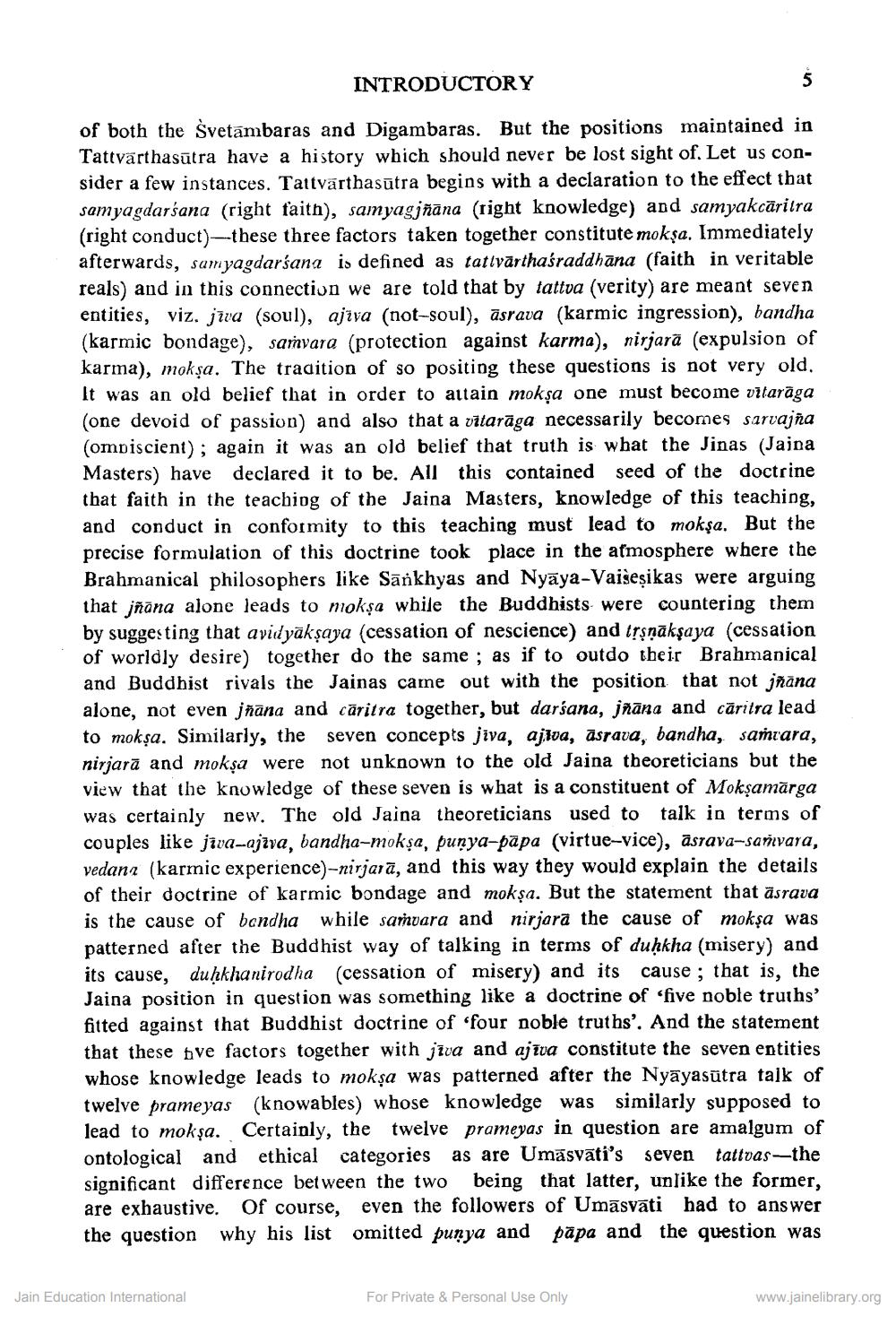________________
INTRODUCTORY
of both the Svetambaras and Digambaras. But the positions maintained in Tattvärthasūtra have a history which should never be lost sight of. Let us consider a few instances. Tattvarthasūtra begins with a declaration to the effect that samyagdarśana (right faith), samyagjñāna (right knowledge) and samyakcäritra (right conduct)--these three factors taken together constitute mokşa. Immediately afterwards, sumyagdarśana is defined as tatlvārthaśraddhāna (faith in veritable reals) and in this connection we are told that by tattva (verity) are meant seven entities, viz. jiva (soul), ajiva (not-soul), āsrava (karmic ingression), bandha (karmic bondage), sarvara (protection against karma), nirjara (expulsion of karma), mokşa. The tradition of so positing these questions is not very old. It was an old belief that in order to attain mokṣa one must become vitaraga (one devoid of passion) and also that a vitarāga necessarily becomes sarvajña (ompiscient); again it was an old belief that truth is what the Jinas (Jaina Masters) have declared it to be. All this contained seed of the doctrine that faith in the teaching of the Jaina Masters, knowledge of this teaching, and conduct in conformity to this teaching must lead to mokşa. But the precise formulation of this doctrine took place in the atmosphere where the Brahmanical philosophers like Sankhyas and Nyāya-Vaišeșikas were arguing that jñāna alone leads to mokṣa while the Buddhists were countering them by suggesting that avid yakşaya (cessation of nescience) and trşņākşaya (cessation of worldly desire) together do the same ; as if to outdo their Brahmanical and Buddhist rivals the Jainas came out with the position that not jñāna alone, not even jñāna and caritra together, but darśana, jnana and caritra lead to mokşa. Similarly, the seven concepts jiva, ajiva, assava, bandha, samrara, nirjarā and moksa were not unknown to the old Jaina theoreticians but the view that the knowledge of these seven is what is a constituent of Mokşamārga was certainly new. The old Jaina theoreticians used to talk in terms of couples like jiva-ajiva, bandha-mokşa, þunya-papa (virtue-vice), āstava-sanvara, vedana (karmic experience)-nirjarā, and this way they would explain the details of their doctrine of karmic bondage and mokşa. But the statement that asrava is the cause of bondha while saruara and nirjara the cause of mokşa was patterned after the Buddhist way of talking in terms of duḥkha (misery) and its cause, duhkhanirodha (cessation of misery) and its cause; that is, the Jaina position in question was something like a doctrine of 'five noble truths fitted against that Buddhist doctrine of four noble truths'. And the statement that these five factors together with jiva and ajīva constitute the seven entities whose knowledge leads to mokya was patterned after the Nyāyasūtra talk of twelve prameyas (knowables) whose knowledge was similarly supposed to lead to mokşa. Certainly, the twelve prameyas in question are amalgum of ontological and ethical categories as are Umāsvāti's seven tattvas--the significant difference between the two being that latter, unlike the former, are exhaustive. Of course, even the followers of Umāsvāti had to answer the question why his list omitted punya and papa and the question was
Jain Education International
For Private & Personal Use Only
www.jainelibrary.org




